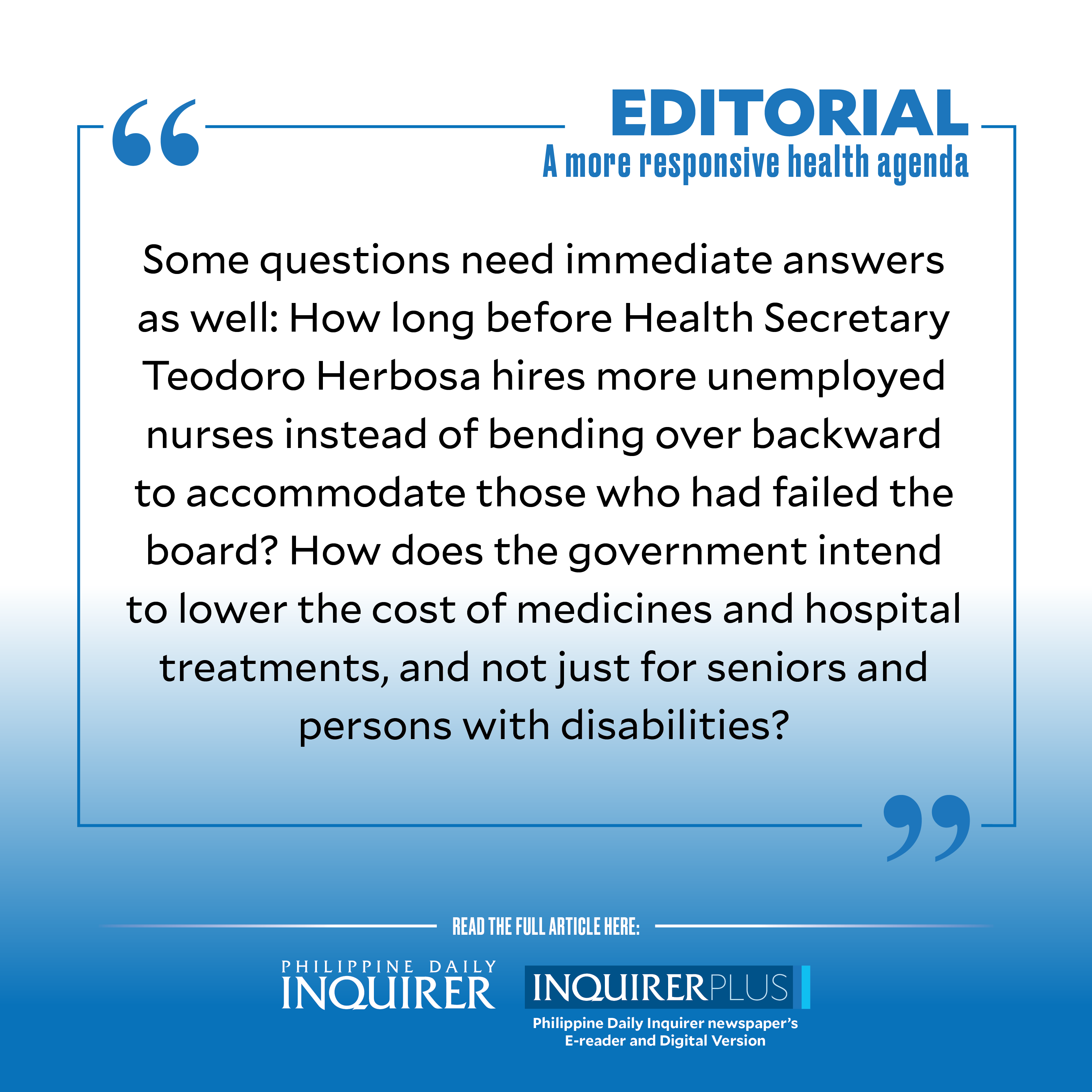A more responsive health agenda
It’s definitely good news for the more than 70,000 Filipinos undergoing dialysis for chronic kidney disease (CKD), who are expected to benefit from the Philippine Health Insurance Corp.’s (PhilHealth) increased coverage of the blood-cleaning procedure, from 144 to 156 sessions a year. At least seven million Filipinos suffer from CKD, with one individual getting the disease every hour, according to the National Kidney and Transplant Institute (NKTI).
The NKTI ranks kidney disease as the seventh leading cause of death in the Philippines, while data from the Institute for Health Metrics and Evaluation showed that CKD has become the fourth most common cause of death in the country in 2019, after ischemic heart disease, stroke, and lower respiratory infection. Tuberculosis was fifth.
Article continues after this advertisementWith a dialysis session costing upwards of P2,000 in most hospitals, and majority of patients needing three sessions a week, the increased PhilHealth coverage is indeed a life-saving development. President Marcos thus highlighted it as among the accomplishments of his year-old administration in his State of the Nation Address (Sona) last month.
The President’s memo dated July 27 adopting the Philippine Health Facility Development Plan 2020-2040 (PHFDP) is just as welcome, as it urges local government units to set up health facilities in their own jurisdiction.
With its P15-billion budget, the plan is expected to translate the universal health care (UHC) law passed in 2019 into “an accessible, efficient, and strengthened health-care system.”
Article continues after this advertisementImplementing the UHC is “one of the biggest projects” of his administration, the President said last June, adding that the law states that “everyone who’s a Filipino citizen should be supported in buying medicines [and] consulting a doctor … We should also help them in their hospitalization and their treatment.”
As a report by several economists, including former economic planning chief Ernesto Pernia noted, the UHC is expected “to significantly reduce the high OOP (out-of-pocket) expenditure for health. In 2017, about 54.5 percent of total health payments came from Filipinos’ own pockets, with medicines and drugs as the main contributors. Lack of PhilHealth coverage of medicines for outpatients and the high cost of drugs and medicines in the country push the OOP expenditure up.
“High out-of-pocket medical expenses push more people into poverty,” Pernia said.
While the UHC is expected to be fully implemented in 10 years’ time, there’s no harm in rolling out its benefits earlier and more expeditiously. The memo is a good start, with Department of Health (DOH) undersecretary Maria Rosario Vergeire listing down government hospitals under the program which would have allocation for neonatal, heart, lung, kidney, and cancer specialty centers. Most of the hospitals are outside the National Capital Region, though it wouldn’t hurt to include more health facilities in the really remote areas.
So far, these health initiatives sound good on paper and their stated noble intentions are commendable. But given the DOH’s record for stodgy bureaucratic processes, as in the much delayed COVID-19 allowances for health-care workers, the sectors concerned cannot be blamed for being cynical.In his Sona, the President vowed to release the special allowances as a way of paying back health workers for facing the risks posed by the pandemic. But would the overdue allowances still be released despite the lifting of the public health emergency last month? The workers wanted to know.
A categorical assurance that they would be released, and a specific date when, are still forthcoming from the DOH and the President despite the fact that the allowances had been part of the pandemic budget.
Such indifference to the plight of health workers has led to the exodus of Filipino nurses to friendlier shores, a worrying phenomenon that Mr. Marcos said in his Sona was being addressed “through education reforms, continuous training, and ensuring their welfare.” He cited the deployment of Filipino doctors to almost 200 municipalities across the country and vowed to deploy more in the remaining 19 towns.
Well and good. But can we have more specifics on the government’s long-term health agenda beyond what has been started? An extensive information campaign on PhilHealth benefits would help, too. For one, can we hear more about PhilHealth’s Konsulta package that’s supposed to give members access to free medicines and consultations?
Some questions need immediate answers as well: How long before Health Secretary Teodoro Herbosa hires more unemployed nurses instead of bending over backward to accommodate those who had failed the board? How does the government intend to lower the cost of medicines and hospital treatments, and not just for seniors and persons with disabilities?
With the President’s ringing promise to focus on health care, can we dare hope that much-needed medical facilities would be among the priority infrastructures supported by the Maharlika Investment Fund?

















